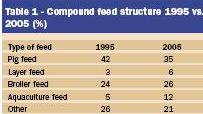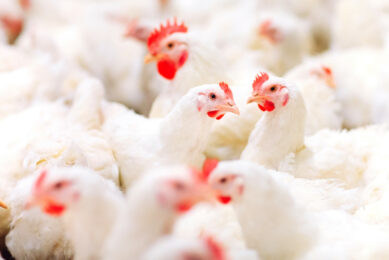China: sleeping giant rapidly awakens

China is one of the largest feed producing countries in the world, importing plenty raw materials for feed. The development of the Chinese feed industry cannot be separated from the world, and the development of the global feed industry relies on China. A healthy development of the feed industry in this country will surely make a significant contribution to the development of the global feed industry.
China
modern animal husbandry and aquaculture development. The feed industry in China
began its
|
development toward the end of
the 1970s, and after more than 20 years of growth and vigorous
development, has effectively transformed back yard farming towards intensified
and modern livestock production. The country has also made great contributions
in satisfying the needs for protein by the general public, facilitating the
readjustment of the Chinese agricultural structure, prospering the rural economy
and increasing farmers’ income. This tremendous achievement has, in turn,
attracted worldwide attention.
The output of Chinese feed products has
maintained stable and rapid growth. Between 1980 and 1990, the overall output of
feed across the country gained an annual increase rate of almost 30%, and
between 1990 and 2000, the annual increase rate was more than 10%. From 1996,
the total feed production in China ranked second place in the world (after the
US). In 2005 alone, the production value of the feed processing industry
|
| There are over 15,000 feed millers in China, but the top 10 companies manufacture 21% of the total output and the first 30 make up 40% of total output. (Photo: Xuyi) |
stood
at 274.2 billion yuan (€26.36 billion), while the output for industrial feed
reached 107 million tonnes. Between 2000 and 2005, the annual increase rate of
outputs for industrial feed, compound feed, concentrated feed and feed additive
premix was 9.5%, 7.7%, 18.9% and 16.8% respectively. As the backbone of the feed
industry, feed additives have also made remarkable progress.
with the total production increasing from 78,000 tonnes in 2003, to 336,000
tonnes in 2005. Vitamin and mineral feed additives can basically satisfy the
needs of domestic markets with some volume being exported to foreign
countries.
in facilitating a healthy development in the international feed industry.
The increasing rate for compound
feed, concentrated feed and feed additive premixes has remained on a high level.
The proportion of compound feed has seen a small decrease, while the proportion
of concentrated feed and feed additive premixes have increased with product
structure being matched more closely with the demands of the Chinese livestock
industry. The production of compound feed for aquaculture and ruminant
concentrated feed supplements have been increasing more rapidly than other
feeds.
data):
• East – 10 provinces, 48.61 million tonnes (45% of total)
• Middle
– 6 provinces, 24.58 million tonnes (23%)
• Northeast – 3 provinces, 14.76
million tonnes
(14%)
• West – 12 provinces (no statistics from Tibet),
19.38
million tonnes (18%).
experienced the attack of highly pathogenic avian influenza (bird flu) and
Streptococcus suis
pig disease,
as well as a big rise on raw material demands. The risk awareness of feed
enterprises has since been enhanced. The industry has also become more mature
and, in terms of production and profits, has steadily increased. It can
therefore be said that the feed industry in China has transformed from
volume-specific to both volumeand quality-specific.
Law and regulation systems have
gradually improved and the industry has maintained healthy development. The
Chinese government has always paid much attention to the safety of feed and,
since 1999, has formulated and implemented the “Regulations for Management on
Feed and Feed
|
Additives”, formulating a series of normative law
documents.
With the application of science and
technology, feed conversion rate has been greatly improved with raising cycle
shortened and efficiency enhanced. Feed science, technological innovation and
science transformation have become the main reasons for promoting sustained and
healthy development of the industry, animal husbandry and aquaculture. Through
diversified merger activities, the number of feed enterprises has decreased,
while produced volume per enterprise has increased. In 2004, the number of feed
enterprises, with an annual output of over 100,000 tonnes, reached 70. The top
10 feed enterprises produced more than 20% of the total output of the
country.
China has proactively taken part in
international competition. At the beginning of reform, CP Group of Thailand and
other foreign large-scale feed companies have entered into the Chinese market.
Now, after more than 20 years of vigorous growth and development, some of
China’s feed
products hold a strong position in the competitive international
market. The market share of feed grade vitamin A, E and C accounts for 30-50%.
The use of L-Lysine is no longer dependent on imports, and China even exports
some of its products.
have been close to the international level, with export volume of feed
processing equipment increasing year by year, which has been warmly welcomed in
the Southeast Asian region. A group of feed processing enterprises have invested
in running feed processing companies in this region. These companies have the
ability to participate in international competition. The feed industry in China
as a whole has sound development, however, since the first three months of 2007,
the industry has experienced a decline in output due to the impact of bird flu.
A decrease in the overall income of animal husbandry has also been evident. Feed
enterprises are facing severe challenges, but, according to market experts, the
situation will change from the second half of this year.
The Chinese
government has attached great importance to the healthy development of the feed
industry and has released guidelines and recommendations in relation to the
industry’s growth and development, as
| |
| The Chinese feed industry is catching up rapidly. (Photo: Xuyi) |
well as given proactive support in terms of national budget,
taxation and finance. China has exempted feed processing enterprises from value
added tax, and even before 1994, feed enterprises had been exempted from income
tax, thus safeguarding the feed industry as one sector which supports
agriculture to move towards healthy development. The introduction of the (free)
market mechanism is the fundamental reason for the rapid growth of the feed
industry which, in China, has benefited from the reform and opening up in 1970s,
as well as the establishment of the socialist market system. The Chinese leader
of second generation, Deng Xiaoping, pointed out as early as in 1983 that “feed
should be operated as an industry, and this would be a big industry”.
“mass participation”, and operated in a diversified manner, such as
multi-element investment, market-driven operation system, commercialisation of
key technologies, enterprise group development and standardising of sector
management. The role of labour, knowledge, technology, management and capital
has been brought into full play.
Privately owned enterprises under
severe market competition have finally come into being and have occupied most of
the Chinese feed industry, which has become one of the sectors that have enjoyed
the highest development towards market operation. The China Feed Industry
Association (CFIA) has played an important part in this by strengthening
professional ethics and promoting its development. CFIA, established in 1985
after the approval by the State Council of the People’s Republic of China, was
the earliest industry association in the country with its function of
intermediary and professional ethics management, which links government and
enterprises. The Association takes a proactive role in the formulation of laws,
regulations and development programmes in relation to feed.
Although achievements have
been made, the feed industry in China still faces some constraints and new
challenges. Firstly, due to the increasingly demand for animal products and the
improvement of the commercialisation and degree of scale of production for
animal husbandry, there is still a big demand for some raw materials for feed.
Fish meal, an important animal protein feed, still relies on imports with annual
import volumes reaching 1 million tonnes. About 70% of soybeans for meal
production need to be imported with annual imports reaching 20 million tonnes.
The resources of protein feed in China will face a long-term shortage
situation.
regions with unbalanced growth. In China, there are currently 15,000 feed
enterprises, of which 2,800 enterprises produce more than 10,000 tonnes of feed
annually. There are 77 enterprises with annual production of more than 100,000
tonnes. The feed enterprises in the west operate on a relatively small-scale
with rather backward management means.
In the long-term, the
Chinese feed industry will establish a safe, qualitative and highly efficient
production system, and create a new type of industrialised path through sound
science and technology, good economic returns, low resource consumption and a
less polluted environment in order to realise a harmonised and coordinated
development for safety, quality
| |
| Sha Husheng: The Chinese feed industry still faces some contraints and challenges. (Photo: Dick Ziggers) |
and high efficiency. A balance between
supply and demand will also be ensured, as well as quality and safety. Industry
structure will be optimised, international competitive edge for feed enterprises
enhanced, and the laws and regulation system for feed will be further completed
and improved. In order to adapt to the trend of a more intensified livestock
industry, feed manufacturers will accelerate the development of concentrated
feed, concentrate supplementation and feed additive premixes to realise a
diversified feed system and multiple feed structures. The sector is expected to
proactively develop new types of feed resources and varieties, and accelerate
the updating of feeds with the aim of satisfying the needs for feed products for
different livestock varieties and methods.
By doing so, the CFIA realises
that it needs to implement and improve the system of production permit and press
ahead for GMP and HACCP safety management systems among feed enterprises with
the aim of maximum reduction of risks. The industry should accelerate the speed
of integration and updating level for feed enterprises, proactively
implement brand strategies to create a group of “Chinese Brands” and support a
number of feed enterprises with international competitive strengths, thus giving
imputes to the development of medium- and small-scale enterprises so as to raise
the modernised level of the Chinese feed industry.
- This is an edited version of a paper prepared by Yang Hongjie and
presented by Chinese feed industry representative Sha Husheng at AFMA-forum in
Sun City, South Africa.
11.7











